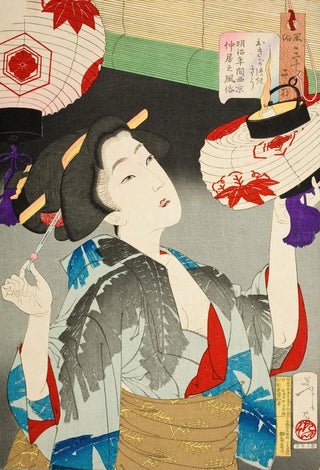Art print of Observer's Gaze: The Appearance of a Kyoto Waitress during the Meiji Era - Tsukioka Yoshitoshi


View from behind

Frame (optional)
Observant gaze The appearance of a Kyoto waitress during the Meiji era: a frozen moment in time
This art print reproduction of the painting "The appearance of a Kyoto waitress during the Meiji era" captures the essence of a pivotal period in Japan. The composition, rich in detail, features a waitress dressed in a traditional kimono, her delicate features illuminated by soft lighting. The pastel colors, blended with vibrant touches, create an atmosphere that is both serene and lively. The ukiyo-e print technique, characteristic of Yoshitoshi's work, allows viewers to feel the depth of emotions and the fleeting beauty of everyday life in Kyoto. Every element of the artwork seems to tell a story, inviting the viewer to immerse themselves in this moment of grace.
Tsukioka Yoshitoshi: a master of Japanese art prints
Tsukioka Yoshitoshi, born in 1839, is one of the last great masters of ukiyo-e, a style of art print that flourished during the Edo period and experienced a revival during the Meiji era. Influenced by the social and political upheavals of his time, Yoshitoshi managed to blend tradition and modernity, creating works that reflect the tensions of his era. His career, marked by iconic pieces, testifies to his artistic genius and his commitment to depicting daily life with a unique sensitivity. "The appearance of a Kyoto waitress" fits within this lineage, illustrating the beauty and complexity of Japanese culture during a time of transition.
A decorative acquisition with multiple advantages
Choosing an art print reproduction of "The appearance of a Kyoto waitress" is a wise choice to enhance your interior. Whether in a living room, office, or bedroom, this artwork adds a touch of elegance and serenity. The quality of the reproduction guarantees fidelity to the colors and details of the original work, allowing you to enjoy its aesthetic appeal daily. By integrating this piece into your decor, you invite not only a piece of history but also a calming atmosphere that will delight your guests and enrich your living space.

Matte finish

View from behind

Frame (optional)
Observant gaze The appearance of a Kyoto waitress during the Meiji era: a frozen moment in time
This art print reproduction of the painting "The appearance of a Kyoto waitress during the Meiji era" captures the essence of a pivotal period in Japan. The composition, rich in detail, features a waitress dressed in a traditional kimono, her delicate features illuminated by soft lighting. The pastel colors, blended with vibrant touches, create an atmosphere that is both serene and lively. The ukiyo-e print technique, characteristic of Yoshitoshi's work, allows viewers to feel the depth of emotions and the fleeting beauty of everyday life in Kyoto. Every element of the artwork seems to tell a story, inviting the viewer to immerse themselves in this moment of grace.
Tsukioka Yoshitoshi: a master of Japanese art prints
Tsukioka Yoshitoshi, born in 1839, is one of the last great masters of ukiyo-e, a style of art print that flourished during the Edo period and experienced a revival during the Meiji era. Influenced by the social and political upheavals of his time, Yoshitoshi managed to blend tradition and modernity, creating works that reflect the tensions of his era. His career, marked by iconic pieces, testifies to his artistic genius and his commitment to depicting daily life with a unique sensitivity. "The appearance of a Kyoto waitress" fits within this lineage, illustrating the beauty and complexity of Japanese culture during a time of transition.
A decorative acquisition with multiple advantages
Choosing an art print reproduction of "The appearance of a Kyoto waitress" is a wise choice to enhance your interior. Whether in a living room, office, or bedroom, this artwork adds a touch of elegance and serenity. The quality of the reproduction guarantees fidelity to the colors and details of the original work, allowing you to enjoy its aesthetic appeal daily. By integrating this piece into your decor, you invite not only a piece of history but also a calming atmosphere that will delight your guests and enrich your living space.
12,34 €






